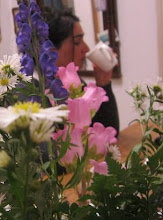Newyorkistan Map
A pastel map, a flat, bird's-eye view of New York City drawn in pen and wash, appeared on the cover of The New Yorker Magazine in its Dec 10, 2001 issue(Note the date: only a couple of months after the 9/11 attacks destroyed the WTC in Manhattan).
It showed the names of the city's neighborhoods Afghanistanicized: Lubavistan, Kvetchnya, Irate, Irant, Mooshuhadeen, Schmattahadeen, Yhanks, Feh, Fattushis, Fuhgeddabouditstan, Hiphopabad, Bad, Veryverybad, E-Z Pashtuns, Khakis and Kharkeezand, and, Lowrentistan, where the World Trade Center once stood.
The map was made by Maira Kalman, who grew up somewhere near Upper Kvetchnya (she did the pen work) and Rick Meyerowitz, who is originally from around Ptooey (he did the watercolor). Both now live in Artsifarsis.
via strangemaps and kottke and SARAH BOXER
A quarter century ago, on March 29, 1976, a simple, pastel map of New York City appeared on the cover of The New Yorker. Drawn from the perspective of a low-flying bird looking west from Ninth Avenue, you could see the world receding from the city: the Hudson River, New Jersey, Kansas City, then the Pacific Ocean and Japan. It was Saul Steinberg's famous "View of the World from Ninth Avenue," a drawing reproduced and imitated countless times.
Perhaps not since Steinberg's drawing had New Yorkers pored over a magazine cover so long. Of course, the maps are totally different. Steinberg's is a delicate drawing done in perfect perspective, with fully realized cars and little witty dotted lines separating Canada from Chicago and Mexico from Washington. The drawing by Ms. Kalman and Mr. Meyerowitz is flat and naןve. Aside from a funny perplexed camel standing in the middle of Stan (Staten Island), the humor is all verbal.
But Mr. Meyerowitz said, "The name never failed to make me laugh when I approached it." The whole map began in fun. "We were on our way to a party in Westchester County," she said. Driving through the Bronx, she suddenly called out: "Bronxistan." And the names started flowing: Le Frakhis (a pun on LeFrak City). Some places on the map have the ring of truth. Lubavistan is roughly where the Lubavitchers live. And parts of Fashtoonks (which derives from the Yiddish for "stink") really did stink once; there were pig farms in New Jersey. "The beauty part of New York," Ms. Kalman said, "is that it is a mishmash. Everybody is running around with a different costume and a different story." New York, like Afghanistan, is made up of tribes with a bunch of exotic names that mean nothing to outsiders. New York City should take second place to no one, as Mr. Meyerowitz said, not even Afghanistan. We are as tribal as anyone. Steinberg's map is tribal, too, but different. His New York is a self- absorbed city. It is us versus them. In the all-important city you can see that taxicabs, people, water towers and windows matter. And far, far away are all those places that don't really matter: the Midwest is yellow, and somewhere out there must be Afghanistan. You can't say those places don't matter to New Yorkers now. Kandahar, Kabul and Kunduz do indeed matter. So do all the -stans and all the -bads. The new map clearly shows that change. It looks like a map of the Middle East has been laid over the whole city. But if you look carefully at New Yorkistan, you'll see New York, resistant as ever. Seventh Avenue is still in Schmattahadeen (the rag district), and La Guardia Airport is still Taxistan. Staten Island will always be just plain vanilla, a place that deserves the name Stan, even if there is a camel standing in it. So the new map is like the old. It is still us against them that wants us dead. If the world gives you Kandahar and Chechnya, send them back Khandibar and Kvetchnya.
This map imaginatively takes this one step further: it divides up New York in new enclaves, at the same time reflecting the fear of contemporary ‘nativists’ and disarming it by placing it in a humourous context. Some examples:
via strangemaps and kottke and SARAH BOXER





No comments:
Post a Comment